The flap over flat polyps: How common are they and how significant to the patient?
The media played up the finding that colonoscopy may be missing so-called flat polyps, but a number of CT colonography experts interviewed by ONI see no need for panic.
Truly flat or depressed colorectal polyps pose a diagnostic dilemma and are always worth a closer look. A study in JAMA may have overstated the case, however, by concluding that these polyps are quite common and carry an increased cancer risk, according to CT colonography experts.
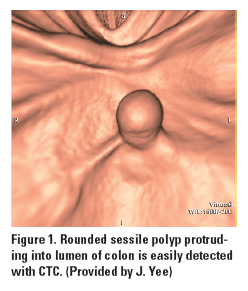
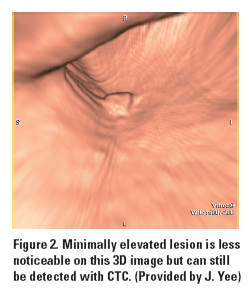
“There were several concerns regarding the study design and its conclusions, which seemed overreaching,” said Beth McFarland, MD, chair of the American College of Radiology’s colon cancer committee. “I think the issues in the article are important to fully evaluate but should be kept in perspective with other larger studies, which followed patients longitudinally with more robust outcome metrics.”
In the JAMA study, Roy Soetikno, MD, and his colleagues at the VA Palo Alto Health System in California sought to determine the prevalence of nonpolypoid colorectal neoplasms in a population of veterans. The patients underwent screening colonoscopy and also had endoscopy with indigo carmine dye if a flat lesion was suspected.
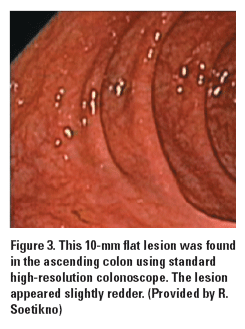
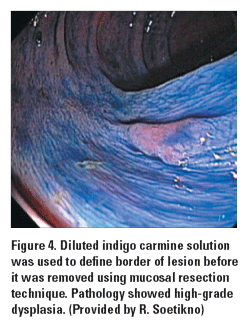
The overall prevalence of nonpolypoid lesions was 9.35%. Broken down by subpopulation, prevalence was 6.01% in the group undergoing colon cancer screening. In the total group of 764 patients with nonpolypoid lesions, the prevalence of cancer was 0.82%. The prevalence in the screening arm was 0.32%.
Dr. Soetikno’s group concluded that in these patients, nonpolypoid lesions were “relatively common... and had a greater association with carcinoma” (JAMA 299:1027-1035, 2008).
Dr. McFarland was concerned with two aspects of the study’s design.
“This study involved an older, male VA population. It was a mixed population of patients for screening, surveillance, and symptoms. The first key question is, What is the application of these results to broader screening populations?” she said.
She also questioned the combination of lesion subtypes and cancer types into such general categories.
“There is always difficulty in terms of the terminology used. Which lesions were superficially elevated vs truly flat or depressed, which are difficult to detect, and how were these types grouped together?” she asked. “There also was some mixing of pathological terminology, combining carcinoma in situ, which most generally is referred to as high-grade dysplasia, along with true invasive cancer, which increased the overall cancer incidence.”
Dr. Soetikno responds
In an e-mail interview, Dr. Soetikno addressed the issues raised by Dr. McFarland. He said that the results in this group of patients could be extended to a larger population.
“The screening population in this study resembles male patients who routinely undergo screening colonoscopy in general practice, albeit there may be a slight increase in the prevalence of colorectal neoplasms among the veterans,” he said.
With regard to the lesion descriptors, Dr. Soetikno acknowledged that superficially elevated lesions should be distinguished from completely depressed lesions. But the latter are very rare, so the term “flat” is commonly accepted as referring to slightly elevated lesions, he said.
National Polyp Study
Dr. McFarland pointed out that the results of the JAMA study differed dramatically from the findings in the National Polyp Study, which noted that flat adenomas were not associated with a higher risk for high-grade dysplasia (Clin Gastroenterol Hepatol 2:905-911, 2004).
“So these lesions were detected and did not have increased cancer risk,” Dr. McFarland said. “The definition of flat adenomas in this study might correlate better with nonpolypoid, superficially elevated, or sessile lesions. The longitudinal National Polyp Study did not demonstrate a high interval cancer rate of these missed lesions, which would argue against poor detection of these lesions with a high cancer potential.”
Dr. Soetikno called the National Polyp Study a landmark but expressed reservations.
“At the time when the NPS was conducted, there was a belief that flat polyps did not exist in the Western population. What you don’t know or don’t believe in, you don’t seek,” he said.
Dr. Soetikno’s group found that flat polyps occur most commonly in the Japanese patient population. A faculty exchange program was undertaken between gastroenterologists and pathologists at the Palo Alto facility and Japanese endoscopists.
“After significant training efforts, we looked for all types of neoplasms, polypoid and nonpolypoid,” Dr. Soetikno said. “We used the newer high-resolution colonoscopes and chromoscopy. Our study provides additional information that potentially can improve the efficacy of colonoscopy used to detect colorectal neoplasms.”
Treatment perspective
From a treatment perspective, flat polyps require extra attention if they wind up being second cancers, said Richard Goldberg, MD, chief of hematology/oncology at the Lineberger Comprehensive Cancer Center, University of North Carolina in Chapel Hill.
“When I’m dealing with colon cancer patients who have gotten adjuvant therapy, their risk [of a second colon cancer] is 1% a year, so looking for flat polyps is highly relevant,” Dr. Goldberg said. “We are essentially following patients to identify new cancers. Because there is a miss rate, you want to be sure that you have an endoscopist who is looking for flat and depressed polyps.”
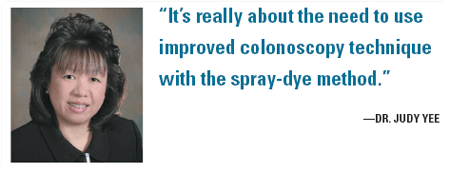
The coverage of this study by the news media was particularly disturbing because they latched on to the 9.35% figure representing the overall prevalence of cancer in this patient population, said Judy Yee, MD, vice chair of radiology at the University of California, San Francisco.
“You need to dissect the Soetikno study down to the types of patients included. The overall prevalence was 9.35%, and everybody is looking at that number. But when you look at the prevalence in the screening population, you see that it was 5.84%, which is similar to the percentage in the Pickhardt study evaluating flat lesions in a screening population,” Dr. Yee said.
Perry Pickhardt, MD, and his colleagues found that flat adenomas measuring 6 mm or greater were uncommon in a typical Western screening population, as were flat neoplasms. They also determined that the sensitivity of CT colonography (CTC) for detecting flat lesions was similar to that for polypoid lesions (Am J Roentgenol 183:1343-1347, 2007).
“In the Soetikno study, the overall prevalence of flat or depressed lesions with cancer was 0.82%. And the prevalence of carcinoma in flat lesions in the screening population was 0.32%. So the prevalence of these lesions and the prevalence of cancer are still low in a screening population,” Dr. Yee said.
But a low prevalence should not be taken as a sign that nonpolypoid lesions can be ignored, Dr. Soetikno said. If anything, his study demonstrated that nonpolypoid colorectal neoplasms can be found in Western populations.
“I think we should focus on improving the methodology and technology of all kinds of screening tests for colorectal neoplasms,” Dr. Soetikno said. “The outcomes of the gold standard colonoscopy can potentially be refined by including the diagnosis and treatment of nonpolypoid colorectal neoplasms.”
Take home message
So what do these study results mean for colon cancer screening, especially in light of the recent update to the American Cancer Society guidelines? All three colon cancer experts agreed that the take-home message should focus on advancing visualization techniques and training readers to look beyond the obvious.
“There should be increased attention by gastroenterologists and by colorectal surgeons who perform colonoscopy to look for these lesions. It’s really about the need to use improved colonoscopy technique with the spray-dye method,” Dr. Yee said. “The ACS guideline focuses on screening. We are proposing to use CTC for screening large number of patients. Flat lesions should not be a significant drawback for CTC screening.”
As for training, Dr. McFarland said that CTC training programs emphasize lesion size and morphologies. Using specific 2D and 3D approaches can increase the likelihood of discerning flatter lesions in a screening program.
“Clearly, nonpolypoid lesions that have some level of elevation can be detected at CTC, as well as optical colonoscopy,” Dr. McFarland said. “It’s always good to remember that these are tough lesions, but I think we are more than compensating for that in terms of how we train for CTC. People need to be aware of these more challenging lesions but also keep them in perspective.”
This article is adapted from ONI’s sister publication Diagnostic Imaging (May 2008).
Newsletter
Stay up to date on recent advances in the multidisciplinary approach to cancer.